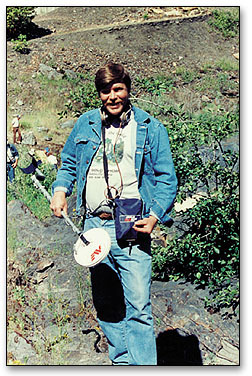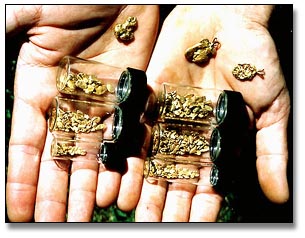
By Marcie Stumpf
It was March, but it certainly didn’t look like spring in Happy Camp. Snow was falling, and it was thick and heavy–but it was warm enough so that it wasn’t sticking very well. But, because it was still cold and damp, we were all standing around the large wood stove warming up.
We were watching Gordon Zahara as he paced back and forth, back and forth, while he told us about the find that he and Lars Larson had made detecting several days before. His pacing was due to his excitement, and the restlessness caused by the weather outside, which was preventing him from being out with his detector.
In late January of this year, when poor weather prevented Lars Larson from mining by his usual methods, Lars bought a Minelab GT16000 detector. He wanted to get right out with it and do some detecting. The problem with that was that there were very few people in Happy Camp during the winter who had time to go out detecting, and Lars wasn’t sure where to go.
 The area around Happy Camp is not well-known as a good detecting area. Most of the people who come here come to dredge or high bank, sluice or pan. The very heavy mineralization of the soil in this area prevented most people from finding any nuggets, until two years ago. At that time, several people who were very good with detectors used the Minelab GT16000 and the Fisher Gold Bug with good results. Interest has been growing ever since then. There are some quite rich old hydraulic areas that have yielded some good nuggets during the summers, but no one had done any hunting in the winter.
The area around Happy Camp is not well-known as a good detecting area. Most of the people who come here come to dredge or high bank, sluice or pan. The very heavy mineralization of the soil in this area prevented most people from finding any nuggets, until two years ago. At that time, several people who were very good with detectors used the Minelab GT16000 and the Fisher Gold Bug with good results. Interest has been growing ever since then. There are some quite rich old hydraulic areas that have yielded some good nuggets during the summers, but no one had done any hunting in the winter.
Before commitments took him away from detecting for awhile, Gordon spent some time on the creek claims last summer, and found several nuggets in high bedrock crevices. That really enthused him about the possibilities for detecting in this area. All the creeks in the area are known for their nice nuggets. There are also all the hydraulic tailings on the river, to say nothing of the high bedrock areas of the river to check out!
His return from a two-month trip coincided with Lars’ purchase of his new detector. The two wasted no time in teaming up. Gordon has a Garrett Groundhog that he has had quite a while, and uses a Depthmaster for enhancement. He knows his detector so well, and has such good results, that he is reluctant to change.
Lars, who is new to detecting, was enthused to have someone who was experienced to give him some tips. Unfortunately, the weather turned really rotten, and for two weeks there were never less than six inches of snow on the ground, so the two of them turned to other things, trying to accomplish as much as possible. This would allow them to have more time for detecting as soon as the weather cooperated.
Eventually it did, and we had a week of beautiful weather. By this time, Gordon had so many ideas that he wanted to try that he and Lars did not know where to begin. However, since Lars was new, they tried some of the areas that had produced nuggets in the past, and turned up a few.
The second area they worked was the one that first started producing nuggets two years ago, and has been worked heavily during the last two summers. To enhance their chances, they took along a special rake developed for nugget hunting several years ago. It allows you to go over an area that has good response, working very close to the soil. It has a deep flat edge so that once you’ve gone over it, the surface rocks can easily be removed with minimum disturbance of the soil. After covering the area closely, and removing the targets, the other side is used, which has wide, rounded teeth for removing the top two inches of soil. A large point on one end removes more deeply embedded stones. A flip of the rake to your flat edge again will smooth out the soil, and, “voila,” you essentially have new ground to work. Experienced guys can find nuggets weighing about two tenths of a grain, and you don’t detect those very deep!
Well, they made all their arrangements, and the first nice day they packed a lunch, told everyone not to expect them until late, and headed for their target area with their equipment.
It was a beautiful day—deep blue sky with a few puffy clouds, bright sun, and just a few small patches of snow here and there. You have to experience the air here to believe how sweet it smells, and all this just added to their happiness at finally getting out to detect.
They started out using their rakes, to see if this technique would yield up more treasures; and sure enough, Gordon found a nugget right off. Lars was detecting in an area nearby, but after Gordon hit the third nugget just a few minutes apart, he accepted Gordon’s offer to work the same area.
The day passed very quickly as they continued to work the same area over and over, using the raking technique. They were amazed when the light started to fail, because they were still in the same spot. They had worked all day in an area no larger than 3 feet by 10 feet, and they were still getting good responses at day’s end. Their take for the day totaled 27 nuggets, the largest of which weighed over 6 pennyweights.
They went back to the area for three more days, before the snow hit once again. All in all, they had a total of 44 nuggets, with a total weight of over 25 pennyweights, all from that little tabletop area—and with the help of their rakes. They each had one nugget that weighed over six pennyweights, and they were beautiful.
This happened just a couple of weeks ago, as I write this; and the two of them are still out there looking every chance they get. They aren’t in the same area, of course. They haven’t hit another spot as good as that one, but they are having success. An opportunity to get in on the beginning of something that could be very good does not come along very often, and they want to take full advantage of it.
there looking every chance they get. They aren’t in the same area, of course. They haven’t hit another spot as good as that one, but they are having success. An opportunity to get in on the beginning of something that could be very good does not come along very often, and they want to take full advantage of it.
This is such a new area for nugget hunting that there are many possibilities. Their enthusiasm is boundless, and Happy Camp, which has seen several “Gold Rushes,” just may be in for another one. This time, however, for metal detecting nuggets.





